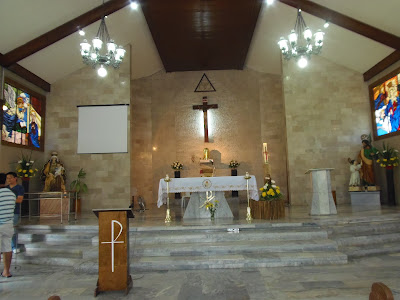Over the weekend, I had a day trip in Metro Cebu. I prepared my to-do list and part of this is Magellan’s Cross, Mactan Shrine and a glimpse of Su Tu Kil Restaurant beside the shrine.
 |
| Chapel of the Cross |
Magellan's Cross is one of the historical places in Metro Cebu. It was planted by Ferdinand Magellan when he arrived at Cebu City on 21st April, 1521. The Magellan's Cross is kept in a small chapel, which is next to Basilica Minore del Santo Nino.
It is believed by some people that the cross is the replica of the original one. Magellan's Cross is a popular tourist attraction of Cebu City.
The cross is now used by Cebu City Hall as a symbol and the image of Magellan's Cross can be seen in the seal of the city. There are more places of tourist interests in close vicinity of Magellan's Cross.
The cross is now used by Cebu City Hall as a symbol and the image of Magellan's Cross can be seen in the seal of the city. There are more places of tourist interests in close vicinity of Magellan's Cross.
 |
| inside the chapel |
The 486-year-old cross is now housed inside a small chapel or kiosk located across from the Cebu City Hall along Magellanes Street, beside the Basilica Minore del Santo Niño. The original cross brought by Magellan is encased in a tindalo wood cross that stands at the center of the chapel. This was done to protect the original cross from devotees who, believing the cross to be miraculous, started chipping off pieces of it.
Ferdinand Magellan was the first European who visited Philippines in the year 1521. When Magellan, along with his crew, arrived at Cebu, he was greeted by Rajah Humabon. During that time Rajah Humabon along with his wife and 800 natives was Christianized. Magellan planted a cross to signify this event.
There is a sign below the Magellan's Cross. According to the sign, the original cross is encased in the tindalo wood cross displayed in the center of the chapel. According to some people, the original cross had been destroyed and the existing cross is the replica of the original one. On the ceiling of the kiosk, where the cross has been displayed, the tourists can see painting that depicts landing of Ferdinand Magellan in Cebu. The planting of the cross has also been displayed in the roof paintings.
Beside the shrine is Basilica Minor Del Santo Nino - built by Miguel Lopez de Legaspi and Fr. Andres Urdaneta on the site where the image of Santo Niño was found in 1565. The church was however destroyed by fire on November 1, 1568 and was subsequently rebuilt in 1602 under the administration of Juan Albaran and was rehabilitated in 1740.
 |
| entrance of the basilica |
In 1521 Ferdinand Magellan gave the Santo Nino Image to Queen Juana as a baptismal gift. Some 40 years later in 1565 Miguel Lopez arrived in Cebu and on finding the natives extremely hostile (arguably due to the actions of the Spanish Invaders) he and his army besieged the settlement and set fire to it.
 |
| painting showing the burning of Filipino settlement |
 |
| altar |
Inspired by his success in bringing Christianity to the people of Cebu, Ferdinand Magellan crossed the narrow channel to Mactan Island in an effort to spread the Catholic faith.
Whilst still wading to the shore, he was killed by island chieftain Lapu Lapu leading his army of men during the battle for supremacy and freedom on April 27, 1521. Magellan's body was never recovered and in 1866 a marker was erected as a monument to this great explorer, marking the spot that Magellan was slain.
There is a great deal spoken with regards to the Hero of the Philippines, Chief Lapu Lapu, much of it surrounded in myth and legend.
It is a big memorial tower approximately 30 meters high, put up to commemorate the great Portuguese explorer, Ferdinand Magellan. The spot is purportedly where Magellan was killed.
However this is a nice place to visit the grounds are very well kept and you can have a great seafood meal in one of the several fish restaurants next to the shrine. I tried the Mana Su Tu Kil Restaurant. The food was great for very affordable price. They serve sea foods cooked in variety of presentations.
 |
| seafood restaurant |
 |
| yum yum yum |
Another place beside the shrine is boutique of seashells decorations. Why not check out the shell vendors just outside the shrine and marvel at the exquisite designs made purely from shells.
 |
| i got one seashell decoration |
Son plus de plaisir dans les Philippines en raison de Magellan’s Cross and Lapu Lapu Shrine!
WAY POINTS
A daily flight from Manila to Cebu.
From Cebu International Airport, Magellan's Cross is located in front of Cebu City Hall. The tourists can reach the spot by availing taxis. Public transport is also available to reach the area. Jeeps can also be availed to reach Magellan's Cross in Cebu.
Mactan Shrine is located in the north-eastern part of the island. From Cebu, one can traverse using the 2 connecting bridges. The easiest is taking the Marcelo B. Fernan Bridge (New Bridge). Take the road going north (to Mactan Export Processing Zone 1) and just follow the main road. About 5 kilometers you will reach the Mactan Shrine. It’s a well-known landmark and asking directions from the locals would be easy.




































